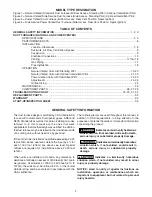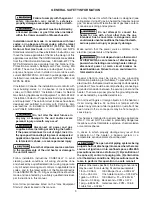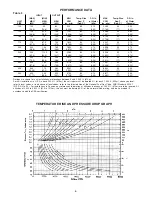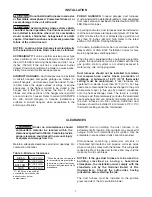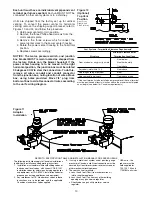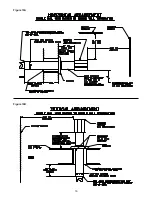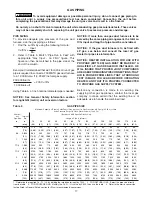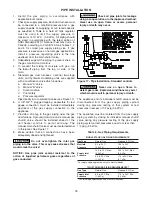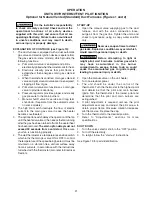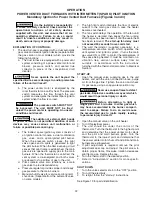
7
INSTALLATION
PUBLIC GARAGES:
In repair garages, duct furnaces
must be installed in a detached building or room separated
from repair areas as specified in the latest edition of NFPA
88B, Repair Garages.
In parking structures, duct furnaces must be installed so
that the burner flames are located a minimum of 18 inches
(457mm) above the floor or protected by a partition not
less than 18 inches (457mm) high. Refer to the latest
edition of NFPA 88A, Parking Structures.
In Canada, installation must be in accordance with the
latest edition of CGA B149 “Installation Codes for Gas
Burning Appliances and Equipment.”
When the unit is equipped with an automatic gas ignition
system, the duct furnace must be installed such that the
gas ignition control system is not directly exposed to
water spray, rain or dripping water.
Duct furnaces should not be installed to maintain
low temperatures and/or freeze protection of
buildings. A minimum of 50
°
F (10
°
C) thermostat
setting must be maintained.
If duct furnaces are
operated to maintain lower than 50
°
F (10
°
C), hot flue
gases are cooled inside the heat exchanger to the point
where water vapor (a flue gas by product) condenses
onto the heat exchanger walls. The result is a mildly
corrosive acid that prematurely corrodes the aluminized
heat exchanger and can actually drip water down from
the duct furnace onto floor surface. Additional duct
furnaces should be installed if a minimum 50
°
F (10
°
C)
thermostat setting cannot be maintained.
Do not install duct furnaces in corrosive
or flammable atmospheres! Premature failure of, or
severe damage to the unit will result!
Avoid locations where extreme drafts
can affect burner operation. Duct furnaces must not
be installed in locations where air for combustion
would contain chlorinated, halogenated or acidic
vapors. If located in such an environment, premature
failure of the unit will occur!
NOTICE: Location of duct furnaces is related directly
to the selection of sizes. Basic rules are as follows:
ACCESSIBILITY:
If unit is a bottom service access type
allow a minimum of 21 inches (533mm) at the bottom of
the unit to facilitate servicing the burners and pilot, or six
inches (152mm) if the unit has a side access burner
drawer. Provision should also be made to assure acces-
sibility for recurrent maintenance purposes.
AIRCRAFT HANGARS:
Duct furnaces must be installed
in aircraft hangars and public garages as follows: In
aircraft hangars, duct furnaces must be at least 10 feet
(3.05m) above the upper surface of wings or engine
enclosures of the highest aircraft to be stored in the
hangar and 8 feet (2.4m) above the floor in shops,
offices and other sections of the hangar where aircraft
are not stored or housed. Refer to current ANSI/NFPA
No. 409, Aircraft Hangars. In Canada, installation is
suitable in aircraft hangars when acceptable to the
enforcing authorities.
CLEARANCES
DRAFTS:
Avoid installing the duct furnace in an
extremely drafty location. Strong drafts may cause pilot
outage. Units with intermittent pilot ignition may be
preferable in areas where drafts cannot be avoided.
Atmospheres containing commercial solvents or
chlorinated hydrocarbons will produce corrosive acids
when coming in contact with the flames. This will greatly
reduce the life of the gas duct furnace and may void the
warranty. Avoid such areas.
NOTICE: If the gas duct furnace is to be used in a
building classified as having a hazardous
atmosphere, the installation must comply with the
standards set by the National Board of Fire
Underwriters. Consult the authorities having
jurisdiction before starting the job.
The duct furnace must be installed on the positive
pressure side of the air circulation blower.
Under no circumstances should
combustible material be located within the
clearances specified in Table 4. Failure to provide
proper clearance could result in personal injury
or equipment damage from fire.
Maintain adequate clearances around air openings into
combustion chamber:
Table 4 - Minimum Clearances
*21" (533 mm) is required for
accessibility on furnaces with
bottom access burner
compartments.
SIDES
TOP
BOTTOM*
FLUE
6" (152 mm)
6" (152 mm)
6" (152 mm)
6" (152 mm)
*When the clearances required
for accessibility are greater than
the minimum safety clearances,
the accessibility clearances take
precedence.
Summary of Contents for NATURAL INDOOR GAS-FIRED DUCT FURNACE
Page 14: ...14 Figure 12A Figure 12B...
Page 15: ...15 Figure 13A Figure 13B...
Page 34: ...34 NOTES...
Page 36: ......


